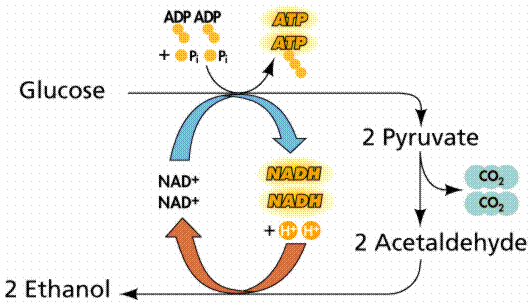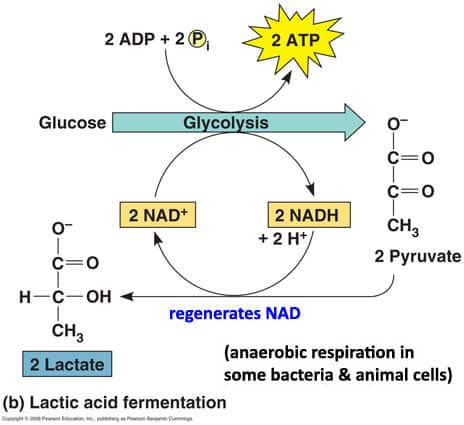In the aerobic cellular respiration, NAD+ is reduced into NADH used to produce ATP, and then NADH is oxidized back to NAD+ in ETC. These conversions allow the aerobic cellular respiration to continue and will not be blocked by the lack of NAD+ to start. However, in the anaerobic situation, ETC is not allowed to occur since there is no oxygen acts as the final electron acceptor. Therefore, there are two fermentation processes that can transfer the hydrogen atoms of NADH to cerain organic molecules instead of the ETC.
Ethanol fermentation:
After finished the glycolysis of one molecule of glucose, two pyruvates, two ATP and two NADH are generated. Instead of undergoing pyruvate oxidation, NADH passes its hydrogen atoms to acetaldehyde, a compound formed when a carbon dioxide molecule is removed from a pyruvate by the enzyme pyruvate decarboxylase. 2 ethanol molecules are produced as the final products, and 2 carbon dioxide molecules are released as the byproducts. Since the NADH generated in the glycolysis are all oxidized back to NAD+, there are only two ATP generated in the process.
Ethanol fermentation usually carried out by yeast, and used to make breads, wine, beer…

Lactate (Lactic Acid) fermentation:
Another type of fermentation, that happens during strenuous exercise in human and animals, muscle cells respire glucose faster than oxygen can be supplied, and then oxidative respiration slows down and lactate fermentation begins. NADH generated in the glycolysis transfers its hydrogen atoms to pyruvate in the cytoplasm of the cell, regenerating NAD+ and allowing glycolysis to continue. This results the change of pyruvate into lactate. The accumulation of lactate molecules in muscle tissue causes stiffness, soreness, and fatigue.

没有评论:
发表评论